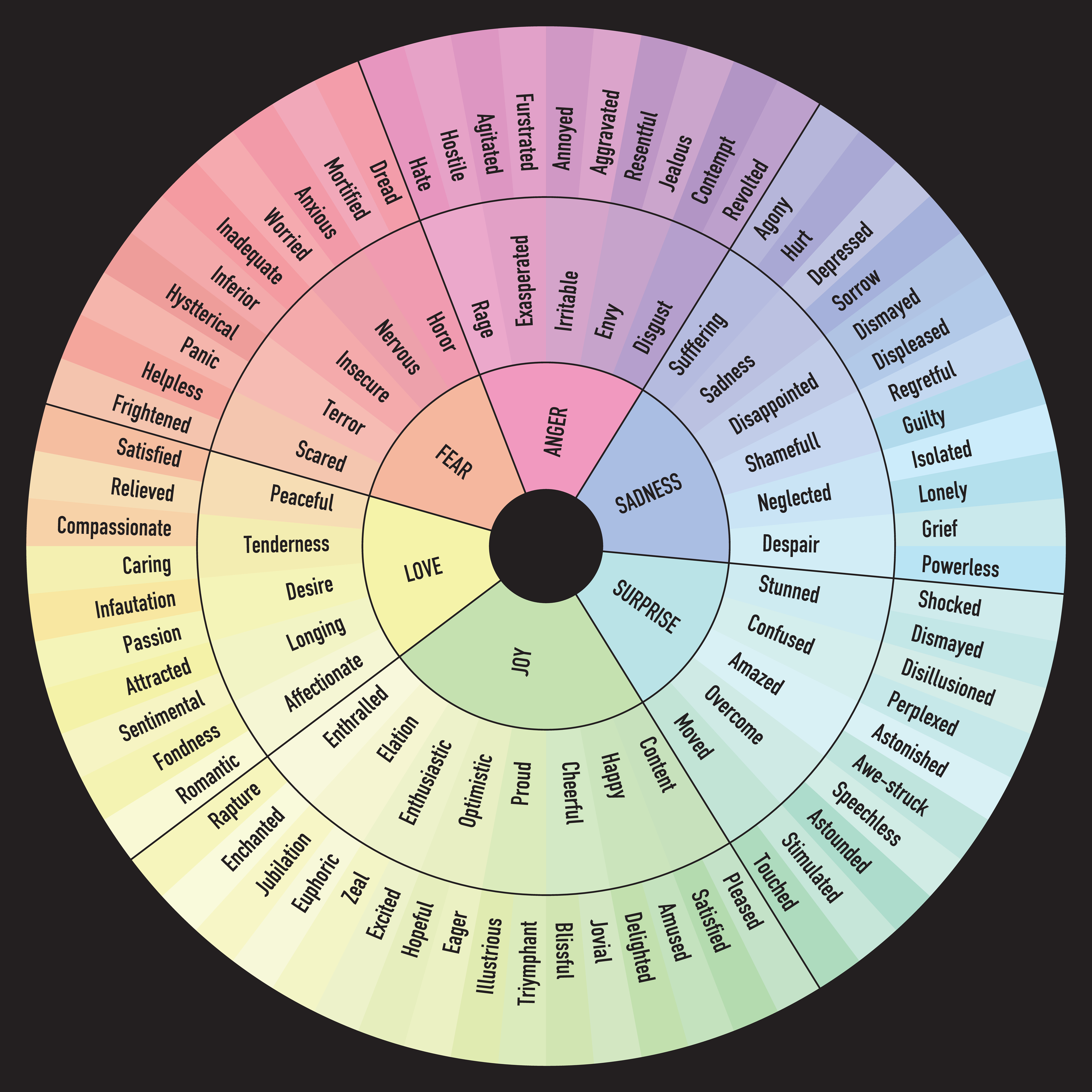Emotions Wheel Brilliant Ways To Use Them
Children also experience complex emotions as adults do. They feel a myriad of emotions ranging from frustration to excitability, nervousness to sadness, jealousy to worrisome, embarrassment to anger, and whatnot. However, unlike adults, we see that young children don’t have the total capacity to communicate their emotions with others. Instead, there are different ways other than speaking they use to share feelings. Children can express their feelings with the help of different things involving their body, facial expressions, gestures, behaviors, and play. Often, it is customary to see them acting out in ways such as throwing tantrums.
Emotional skills and learning are crucial aspects of a child’s development in their early years. This time, they need to fully identify, manage, and express their feelings to do it healthily once they grow to be adults. Some of the ways they do include different relationships and social interactions with other people, especially adults, that surround them most of the time.
As a parent, you have a significant role in helping your kids genuinely understand their emotions and behaviors. Children need to be guided by their parents on managing their emotions in healthy and positive ways.
Table of Contents
Emotions Wheel

The Emotions Wheel tool is from the clinical psychologist Robert Putchik. The wheel comes with eight primary emotions, put into different categories. As the Emotions Wheel for children needs to be simple, it would not have any other classes. Children of all ages should be able to use the Emotions Wheel specifically designed for them. Children who struggle to express and communicate their emotions may find it helpful.
Upon regular use, Emotions Wheel will aid children in identifying the ever-changing dynamics of their emotions. It will also help them identify the possible triggers for specific emotions.
Ideally, the emotions wheel is designed for children ages 4 to 11 and is used individually. However, before using the resource with a kid, you need to know how to use it correctly. You can download a printable version here.
How to Navigate the Emotions Wheel
The feeling wheel or the Emotions Wheel has a center, the bullseye, representing the primary emotions one faces. So, these would be like the descriptors the toddler would utilize. These include being sad, scared, happy, and so on. When we move outside of the center, we come to know more in-depth findings that may help us constitute the mainstream emotions we face.
The Advanced Emotions Wheel also has empty spaces in the outermost rings where users can fill in the feelings of their choice. Children having a tough time identifying their emotions can use this open space to express themselves.
The central and peripheral rings represent feelings in more detail which may constitute the mainstream emotions. What’s more, the Emotions Wheel is also expressly made to reflect any contrasting feelings. For example, the opposite of feeling fear is peace and calmness.
Also, sad is the opposite of happy. So, such contrasting feelings get put on the opposite corners of the circle. What’s more, it helps enlist the emotions on a visual scale that helps in separating and grouping them. For example, your kid may indicate a feeling for light intensity with a pastel color and a heavy intensity represented by a dark color.
However, as parents, our jobs not only end with an Emotions Wheel. We would also need to analyze how our children get affected by different situations critically. Strategic advantages through various tools can help us do so.
How Can You Implement an Emotions Wheel for Your Kids?
There are several implementations of the Emotions Wheel for your kids. Let’s identify some of them.
Go to The Root Cause of the Misbehavior
Misbehavior is a complicated outburst of emotions in your child. You will have to understand the possible triggers, situations, and the whole history behind a tantrum that your kid throws so that you can navigate through it and solve the issue effectively. It is now evident that misbehavior is not something of a negative trait but an indicator that there is something wrong. Most importantly, misbehavior in children results from poorly managed and expressed emotions.
It might be possible that they feel unwelcome in their peer group. On the other hand, they might feel less important because of emotional neglect from their family. They might also feel there is a lack of control over things they do and how they feel. Consequently, it would tempt the children to act out in a way that calls for attention from everyone. It doesn’t matter if the attention is negative; they feel in control and power when something seems to go right.
Instead of confronting or making them feel about what they are doing, try to help them sit with their emotions. Emotions Wheel is a helpful tool that allows them to identify their emotions and manage them effectively. Eventually, you will see your kid opening up more about the situation as they get the help they need.
This way, you will be able to identify the root cause behind their misbehavior – that it helps in maintaining peace and sanity around. It will also eliminate the need to use negative parenting actions such as criticizing the child.
Choose Problem Solving as the Solution
Punishment is the behavior many parents use routinely whenever their children tend to act out. Unfortunately, it only leads to more disruption as it focuses on the action instead of the preliminary signals that led to the actions. As you can see, punishment doesn’t help identify problems, so you cannot use it as a solution.
Emotions Wheel is helpful as it keeps your parenting role proactive rather than reactive. For instance, you wouldn’t have to spank your toddler deliberately smearing your toothpaste over the sink to catch your eye. Given your rage at that moment, it might be tempting. However, it will not put a stop to your toddler’s misconduct.
Instead, consider the emotions of your toddler doing so. Implement the emotion wheel to identify the exact emotions behind it. Then, try to determine the precise opposites of the feelings your child might be indicating. You may then try instilling in them the emotion they want to feel. So, instead of punishing your child, you empathize with them and solve the problem with a rational mind. As your child learns to talk, communicate with them about the possible ways they can manage their emotions. Doing so will instill a spirit of problem-solving without depending on attention and power-seeking.
As You can see, kids have a plethora of emotions that lead them to act in a certain way. So, the best way to help them feel comfortable with their emotions is to make them understand why they are feeling the way they are or help them healthily communicate their emotions. Then, with the help of labeling through the Emotions Wheel, the kids can feel less overwhelmed.
On a positive note, the Emotions Wheel helps us see that irritation, frustration, and anger are closely associated. So, we can get down to the level of our kids, wait for their response to subside, and help them understand what is making them feel worse.
How to Use Emotions Wheel for Kids
Let’s see the best practices for Emotions Wheel l for your kids:
As a parent, you want to use the Emotions Wheel with your kid to ask them about their day, for example, if they are at school and then come home. Let them share how they feel about the different experiences they shared with you. Now, label the emotions on the wheel and record accordingly.
Refer to Emotions Wheel discussing how you or people surrounding the child might have felt in a particular case. It would instill empathy in them.
Hang the Emotions Wheel as the checkpoint for the kids and yourself to be more expressive about your conversation. In addition, it will help the family members open up with each other as they share their different experiences.
You may also want to make your child choose a song and associate it with a specific emotion.
Final Word
As you can see, there are different benefits and implications to an Emotions Wheel for kids. Not only can you make your children emotionally stable and intelligent, but also you help the whole family get more open with one another. In addition, children facing psychological development delays may also benefit from the Emotions Wheel.
Originally posted 2022-05-02 03:15:47.
Megan Santiago
Latest posts by Megan Santiago (see all)
- How to Find a Trauma Therapist in Tampa - September 30, 2024
- Get Your Child to Listen: A Clear-Cut Way To Feel Heard - March 10, 2024
- Help With Bills – How to Get Financial Assistance - March 10, 2024
